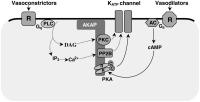KTP-Kanal - Regulation
Figure 1: Schematic diagram of factors that regulate vascular KATP channels. Activation pathways are shown with solid arrows and inhibitory pathways with dotted arrows. The A-kinase anchoring
protein (AKAP) may be important in localising key regulatory enzymes close to the channel to form a regulatory complex. Many vasodilators act through adenylyl cyclase (AC) and PKA to cause
channel activation, while PKA also provides tonic channel activation. Vasoconstrictors acting through phospholipase C (PLC) inhibit the channel through PKC and might also do so by activation of
PP2B or inhibition of AC. Whether these kinases and phosphatases act directly on the channel proteins as indicated remains to be determined, as do the detailed interactions between the regulatory
pathways and other structural elements that may link receptors, AKAP and channel into a signalling complex.
Keywords:
KATP-channel,
KTP-Kanal,
Regulation,
Regulation,
Schema,
scheme,
vasoconstriction,
Vasodilatation,
Vasodilatation,
Vasokonstriktion

